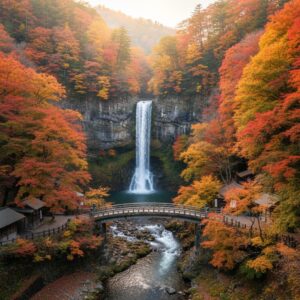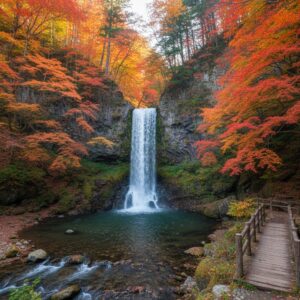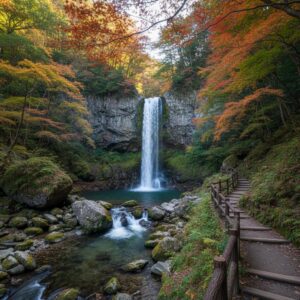When you picture Osaka, what springs to mind? Is it the electric pulse of Dotonbori, a kaleidoscope of neon reflecting in the canal? Perhaps it’s the savory sizzle of takoyaki on a street corner, or the towering majesty of Osaka Castle standing sentinel over a sea of skyscrapers. This is the Osaka we know, the Osaka we love—a city that thrums with an undeniable urban energy. But what if I told you there’s another side to this metropolis, a secret heart that beats to a different rhythm? A place where the only neon is the vibrant green of moss-covered stones and the only towering structures are ancient cliffs carved by water and time. Just a short journey from the city’s bustling center lies Settsu-kyo Park, a sprawling expanse of raw, untamed nature. This isn’t just a park for a gentle stroll; it’s a gateway to an adventure. It’s home to the Akuta River, which has spent millennia carving a dramatic gorge through the earth, creating a playground for thrill-seekers and nature lovers alike. Here, you can trade the crowded subways for rushing river currents and the urban cacophony for the symphony of a cascading waterfall. This is where Osaka sheds its city skin and reveals its wild soul, offering an experience that will challenge your body, refresh your spirit, and fundamentally change the way you see this incredible region. We’re going canyoning and river trekking in the hidden depths of Settsu-kyo, and it’s an adventure you’ll never forget.
For another unique way to experience the park’s natural beauty from a different perspective, consider a walk across the famous Hoshi no Buranko suspension bridge.
The Transition: From Urban Sprawl to Verdant Sanctuary
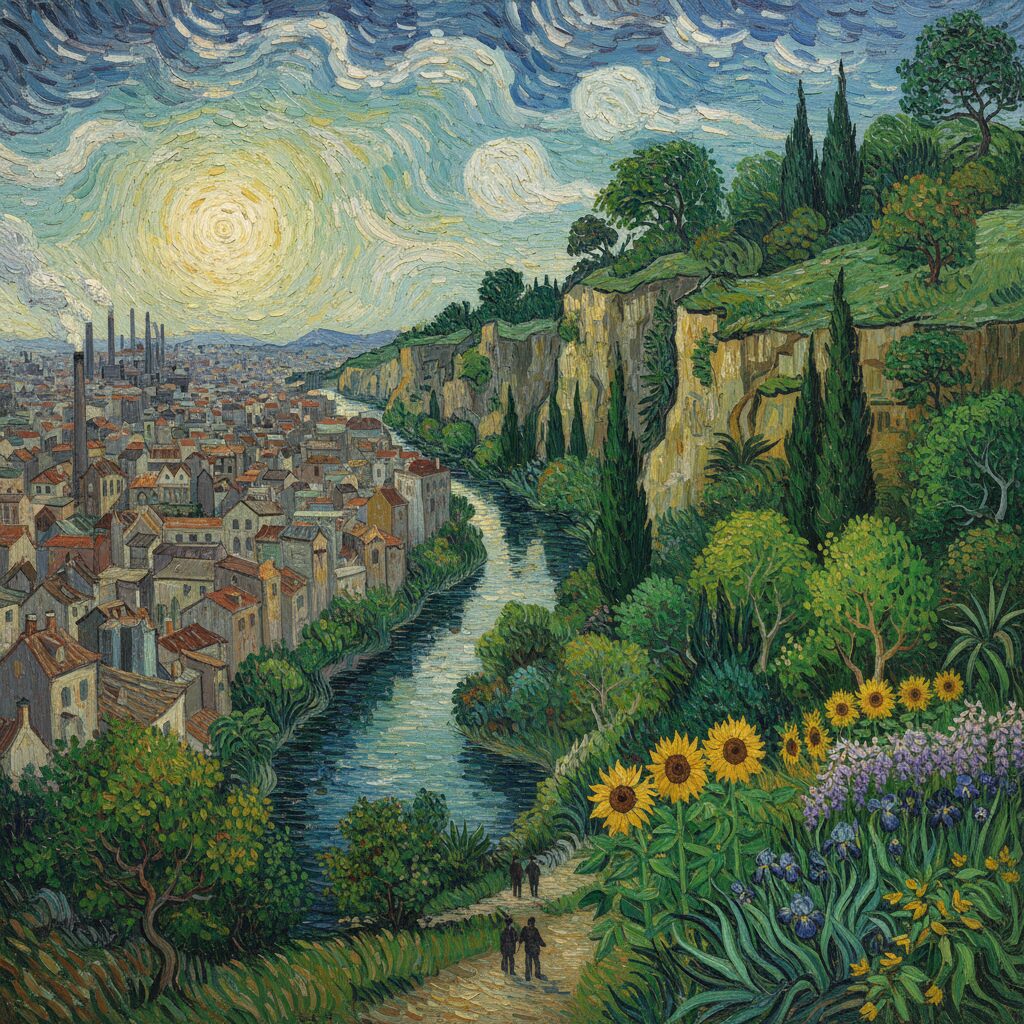
The journey itself is a remarkable part of the experience, a gradual shedding of urban layers. Departing from the architectural maze of Osaka or Umeda Station, you board a train on the JR Kyoto Line, a familiar artery of city life. The view from the window begins as a dense tapestry of buildings, power lines, and concrete—the very essence of a modern Japanese metropolis. But as you speed toward Takatsuki, a city conveniently nestled between Osaka and Kyoto, a subtle transformation unfolds. The buildings become shorter, and the spaces between them widen. Green patches emerge, first as manicured parks and gardens, then as rolling hills in the distance. By the time you arrive at JR Takatsuki Station, the pace already feels different—a welcome downshift from the high-energy hum of central Osaka. The final part of the journey, a brief ride on a local bus, is the true gateway. The bus winds through quiet residential streets before the landscape opens up dramatically. Suddenly, you are flanked by towering bamboo groves and dense forests, the road narrowing as it follows the gentle curve of the Akuta River. The air that filters through the open bus window changes, losing its city edge and replaced by the cool, damp scent of earth, stone, and living green. Stepping off the bus at the entrance to Settsu-kyo Park feels like entering an entirely different world. The temperature drops by several degrees beneath the dense canopy of ancient trees. The dominant sound is no longer traffic, but the ceaseless, soothing murmur of the river, a sound that seems to wash over you and cleanse the urban static from your mind. This initial sensory shift is profound—a powerful reminder that even in one of the world’s most populated areas, true wilderness is never truly far away, patiently awaiting those willing to seek it out.
Gearing Up for the Gorge: Preparation and Respect
Before you can fully immerse yourself in the depths of the gorge, there is a necessary ritual of preparation. It is at this stage that the true essence of the adventure reveals itself. Canyoning, or ‘sawanobori‘ as it is called in Japanese, is far from a simple river dip. It involves an active, dynamic interaction with nature, a journey demanding both appropriate equipment and the right mindset. This is not an activity to be taken lightly or attempted alone, especially for beginners. The rocks are deceptively slippery, currents can be powerful, and mastering the river’s flow is a skill developed over many years. For this reason, hiring a local, certified guide is not merely advisable but absolutely essential for safety and enjoyment. These guides are experts in their field; they know every rock, every pool, and every current in Settsu Gorge. They provide not only critical safety gear but also extensive knowledge of the local ecosystem and an infectious passion for the wilderness. The act of gearing up is transformative. You shed your everyday clothes and don a thick wetsuit, an immediate defense against the river’s cold grip. Then comes the life vest, a buoyant embrace that ensures safety and instills confidence in the water. A robust helmet guards you against any bumps against the gorge walls, and specialized river shoes, often with felt soles, grant you a gecko-like grip on slick, algae-covered stones. Seeing yourself and your group outfitted in this gear, you feel less like a tourist and more like an explorer, prepared to face the elemental forces ahead. The guides lead a thorough safety briefing, delivering instructions with clarity and calm. They teach you how to move, maintain balance, read the water, and, most importantly, trust both your equipment and your own skills. This preparation is more than practical; it is a mental shift, a moment to center your mind, quiet your fears, and open yourself to the raw, exhilarating experience that lies ahead.
River Trekking vs. Canyoning: Choosing Your Adventure
It is crucial to grasp the subtle yet meaningful difference between the two primary activities offered. River trekking, often referred to as ‘sawatozan’ (mountain stream climbing), involves moving upstream. It is a demanding hike through the riverbed, requiring you to wade through currents, scramble over boulders, and sometimes climb small waterfalls. It tests endurance and balance, providing a steady, deliberate way to experience the gorge. Canyoning, conversely, usually involves descending a gorge. It is a more dynamic, adrenaline-pumping sport that incorporates trekking elements but adds thrilling features such as sliding down natural water slides, rappelling down larger waterfalls using ropes and harnesses, and jumping from cliffs into deep, clear pools below. Most guided tours in Settsu-kyo offer a hybrid experience, known as ‘shower climbing,’ which focuses on ascending the river while including many fun, dynamic canyoning elements. You will find yourself climbing waterfalls, battling currents, and enjoying controlled leaps and slides. Guides customize the experience according to the group’s skill level, ensuring that everyone, from cautious beginners to seasoned adventurers, feels both challenged and secure. Regardless of the terminology, the core objective remains the same: to become one with the river, move with its flow, and explore a world unreachable by any other means.
The Heart of the Gorge: A Sensory Immersion

The first step into the Akuta River is a moment of pure, unfiltered sensation. The cold hits you first, a sharp, electric shock that seeps through your wetsuit and awakens every nerve ending. It’s a bracing, primal feeling that instantly sharpens your focus on the present moment. All thoughts of work, emails, or city life vanish with that initial plunge. Then, your senses begin to adjust to this new, aquatic world. Your eyes adapt to the unique light filtering through the gorge. High above, a dense canopy of maple and cedar trees forms a living ceiling, with sunlight dappling through the leaves and casting shifting patterns onto the water and rocks. The gorge walls—sheer cliffs of ancient stone—rise on either side, creating the impression of a natural cathedral. They are covered with a lush tapestry of ferns and emerald-green moss, dripping with moisture and alive with vibrant life. The water itself is astonishingly clear. In the tranquil pools, you can see every smooth stone and pebble on the riverbed, watching tiny fish dart through the shadows. The soundscape surrounds you—a constant, layered symphony of water. There’s the low rumble of the main current, the high-pitched splash of water tumbling over rocks, and the thunderous roar of a nearby waterfall. This is punctuated by the calls of wild birds echoing off the canyon walls and the cheerful guidance of your guide. As you begin to move, you become part of this environment. You learn to place your feet carefully, testing each rock for stability. Your hands help you balance, feeling the rough, cool texture of the stone. You learn to lean into the current, using its power to your advantage. The journey unfolds in a series of incredible vignettes. You might find yourself scrambling up a small waterfall, the water pounding your helmet and shoulders like a powerful massage. The sense of triumph as you pull yourself over the ledge with the help of your guide and teammates is exhilarating. A little further upstream, you encounter a natural slide—a section of rock smoothed by centuries of flowing water. With a whoop of excitement, you launch yourself down, finishing with a refreshing splash into a deep pool below. Perhaps the most unforgettable moments are the jumps. Standing on a rock ledge, peering down into a deep, dark pool of crystal-clear water, your heart pounds wildly. The guide gives a reassuring nod, and you take a leap of faith. For a split second, you are airborne, suspended between rock and water, before the thrilling plunge into the cold, silent depths. Emerging from the water with a gasp and a grin, you feel completely alive. This is no mere sightseeing experience; it is a full-body, multi-sensory conversation with nature in its most powerful and beautiful form.
Life in the Gorge: The Delicate Ecosystem of Settsu-kyo
While the adrenaline-charged activities are the main attraction, a deeper appreciation of Settsu-kyo arises from observing the rich and delicate ecosystem thriving within its rocky boundaries. The guides, with their keen eyes, often pause to highlight the hidden wonders of the gorge. The clear, unpolluted waters of the Akuta River sustain a surprising variety of life. You might notice small, agile fish such as the ‘kawamutsu’ (dark chub) weaving through the currents. If you peer closely into the crevices between rocks, you may spot the tiny, rust-colored shells of freshwater crabs called ‘sawagani’, considered a delicacy in some rural regions of Japan. The gorge is also a sanctuary for amphibians. The chorus of the Kajika frog, whose song is so melodious it is often likened to the ringing of a bell, can sometimes be heard during the quiet evenings. Yet, the most legendary inhabitant of these waters is the Japanese Giant Salamander, or ‘Oosanshouo’. This remarkable creature, which can exceed a meter in length, is a living fossil, a relic from the age of dinosaurs. Recognized as a Special Natural Monument by the Japanese government, they are extremely rare and elusive, preferring to shelter beneath rocks in the river’s deepest parts. Although the odds of spotting one are slim, simply knowing such an ancient being dwells here adds a profound sense of mystery and wilderness to the gorge. The plant life is equally captivating. The rocks are adorned with countless species of moss and lichen, forming a vibrant, soft carpet of green. Ferns of various shapes and sizes sprout from seemingly impossible cracks in the cliff faces. The trees lining the gorge include a mix of evergreens like cedar and pine, alongside deciduous trees, most notably the Japanese Maple (‘momiji’). This rich biodiversity testifies to the river’s health and underscores the importance of preserving natural spaces like Settsu-kyo. Thus, the canyoning experience becomes more than a sport—it transforms into a lesson in ecology, offering a firsthand glimpse into the intricate web of life sustained by this pristine environment.
Beyond the Riverbed: Hiking Trails and Scenic Vistas
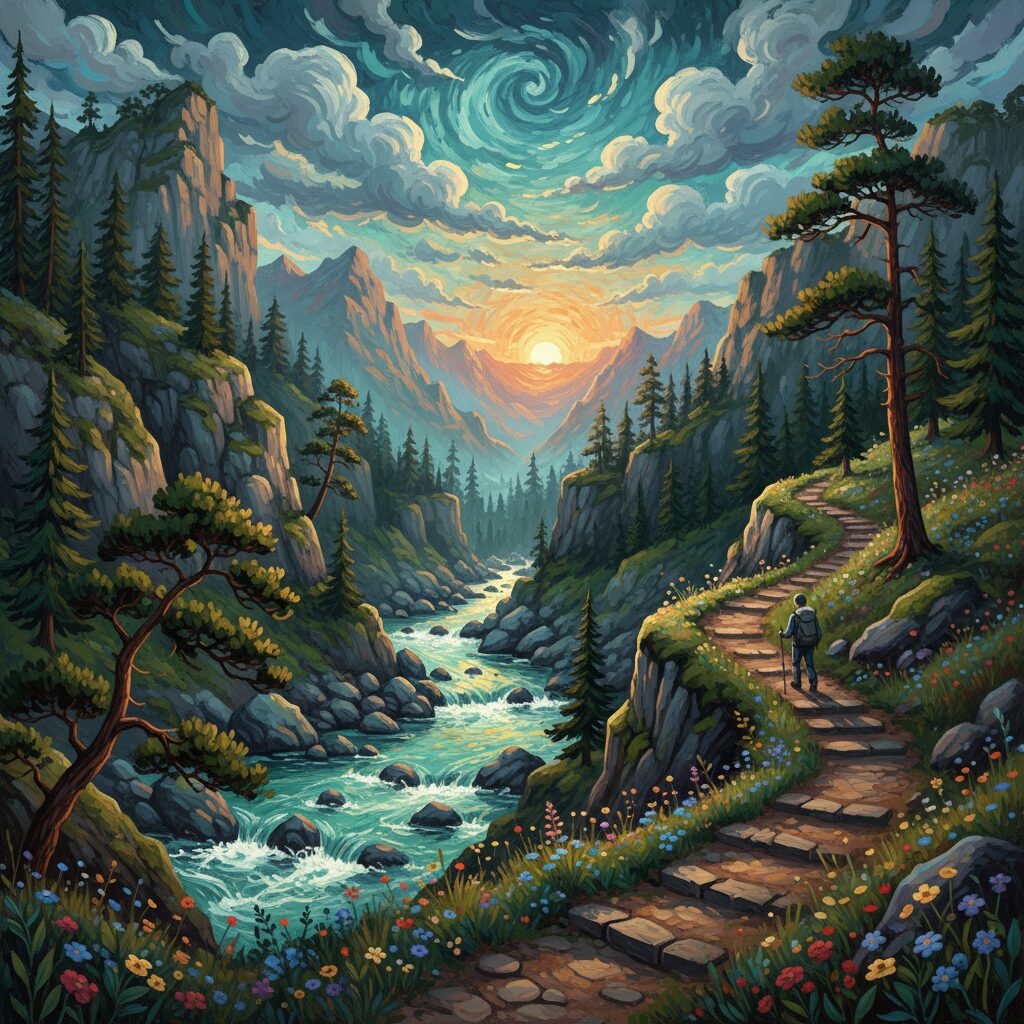
Settsu-kyo Park’s charm extends well beyond the water’s edge. For those who prefer to stay dry or visit during seasons less suited for river activities, the park features an extensive network of hiking trails that reveal a completely different, yet equally breathtaking, view of the gorge. A well-maintained trail traces the river’s path, winding along the ridges and offering spectacular bird’s-eye views down into the canyon you may have just climbed. From these heights, the river looks like a shimmering ribbon of silver and white, and you can watch other groups of canyoners, resembling tiny, brightly colored insects, making their way upstream. The trails themselves are a delight to walk. They meander through dense, silent forests where the air is cool and fragrant with the scent of pine and damp earth. Wooden staircases and sturdy railings assist in steeper sections, making the trails accessible to most visitors with a reasonable level of fitness. One highlight of the trail system is ‘Momiji-bashi,’ a simple yet beautiful suspension bridge spanning a narrow part of the gorge. As you cross it, you feel a gentle sway beneath your feet, and the view down to the rushing water below is both thrilling and awe-inspiring. Further into the park, signs point towards the ‘Shiroato,’ the ruins of Akutagawa Castle. Although little of the original structure remains, the site provides a panoramic view of the surrounding landscape and a tangible connection to the region’s feudal history. These hiking trails allow you to appreciate the gorge’s scale and grandeur in ways impossible from the river itself. They offer moments of quiet reflection—a chance to rest on a bench overlooking a waterfall, listen to the cicadas in summer, and simply soak in the profound peace of the Japanese wilderness.
A Park for All Seasons
The beauty of Settsu-kyo Park lies in its ever-changing nature, offering a unique experience in every season.
Spring (Haru)
Spring is perhaps the most celebrated season in Japan, and Settsu-kyo marks it spectacularly. The park is home to ‘Sakura Hiroba’ (Cherry Blossom Square), an area boasting over 3,000 cherry trees. From late March to early April, the space bursts into a breathtaking cloud of pale pink and white blossoms. The atmosphere is festive and joyful as families and friends gather for ‘hanami’ (flower viewing) parties, spreading blue tarps under the trees for picnics and celebrations. The delicate beauty of the sakura blossoms against the rugged gorge backdrop is a striking contrast.
Summer (Natsu)
As the heat and humidity of the Osakan summer descend on the city, Settsu-kyo transforms into a vital, verdant oasis. The foliage deepens to lush green, and the dense canopy offers a welcome shield from the intense sun. The air within the gorge is noticeably cooler, refreshed by the cold river water. This is peak season for canyoning and river trekking, providing a perfect natural escape from the sweltering city. The vibrant chorus of cicadas becomes the park’s soundtrack, a sound synonymous with summer in Japan.
Autumn (Aki)
If spring is a delicate watercolor, autumn is a vivid oil painting. Starting in mid-November, the park’s many maple trees burst into fiery color. This season of ‘koyo’ (autumn leaf viewing) is as beloved by the Japanese as cherry blossoms. The area known as ‘Momiji-dani’ (Maple Valley) becomes particularly popular, with a canopy of brilliant reds, oranges, and golds. Hiking the trails during this time is magical, as you tread on a carpet of fallen leaves and admire the stunning spectacle of autumn foliage reflected in the river’s clear waters.
Winter (Fuyu)
Winter brings a stark and serene beauty to the park. The crowds thin, and a quiet hush settles over the landscape. The bare branches of deciduous trees create intricate, skeletal patterns against the crisp winter sky. The air is clear and invigorating, perfect for a brisk hike. While river activities are generally unavailable, the park offers a peaceful solitude rare at other times of the year. Occasionally, a light dusting of snow transforms the gorge into a silent, monochrome wonderland, a truly magical sight.
The Practical Guide: Access, Advice, and Sustenance
Navigating your way to this natural paradise is surprisingly simple, showcasing Japan’s excellent public transportation system.
Getting There
Start your journey at either Osaka Station or Umeda Station. From there, board the JR Kyoto Line, a major rail route. Your stop is JR Takatsuki Station. The Special Rapid service trains make for a quick trip, usually around 15-20 minutes. Once you reach Takatsuki Station, transfer to a local bus by heading to the north side terminal. Look for a Takatsuki City Bus bound for ‘Tsukawaki’ (塚脇) or ‘Kamogafuchi’ (下の口). Get off at stops close to the park, such as ‘Settsukyo Guchi’ (the entrance) or a bit further at ‘Shimogawara’ (for lower park access). The bus ride takes approximately 15-20 minutes, with onboard announcements in both Japanese and English. If unsure, showing the bus driver the park’s characters (摂津峡) will usually get a helpful nod and a signal when it’s your stop. For drivers, parking is available, but be warned that during peak times like spring’s hanami and autumn’s koyo, lots fill early and the narrow access roads often become congested.
Essential Tips for a First-Time Visitor
If you’re planning to try canyoning, the most crucial advice is to book a guided tour in advance. Search online for ‘Settsu-kyo Canyoning Tour’ or ‘大阪 摂津峡 キャニオニング’. Reputable companies typically have clear websites with English information, specifying included items such as gear, insurance, and guide fees. For hikers, wear sturdy, comfortable shoes or hiking boots, as trails can be uneven and steep in some spots. Carry water and snacks since food options inside the park are limited. In summer, insect repellent is highly recommended. Regardless of the season, always bring a small bag to carry out your trash. Japan’s natural parks deeply embrace the ‘Leave No Trace’ ethic, so be prepared to take out everything you bring in. Lastly, bring a camera but remember to sometimes put it down—some of the gorge’s most beautiful moments are best experienced fully with all your senses, not just through a lens.
Refueling After the Adventure
After hours of hiking or river climbing, you’ll likely be very hungry. Though the park remains rustic, the area around JR Takatsuki Station is lively with many dining choices to satisfy any craving. Options range from quick ramen and udon shops to relaxed izakaya (Japanese pubs) where you can enjoy grilled skewers, sashimi, and traditional dishes. Bakeries, cafes, and convenience stores are also available for a quick bite. This is a great way to conclude your day: moving from the wildness of the gorge to the comforting, flavorful world of Japanese urban cuisine, sharing stories of your adventure over a well-earned meal.
An Invitation to Osaka’s Other Side
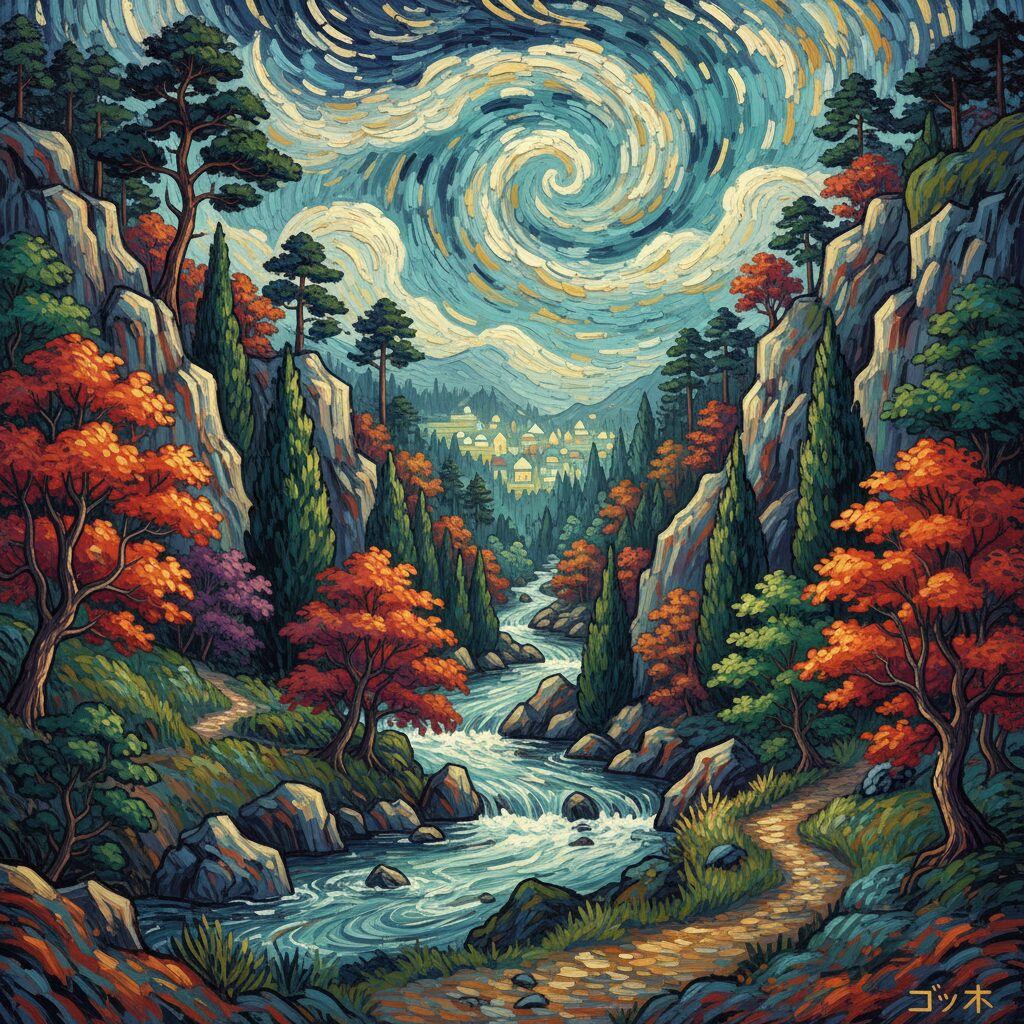
Settsu-kyo Park is more than merely a beautiful spot; it stands as an essential contrast to the Osaka most travelers encounter. It reminds us that even the liveliest and most modern cities maintain a deep, lasting bond with the natural world. Exploring its gorge is also an inward journey. It removes the distractions of contemporary life, compelling you to be fully present—attuned to each step, the feel of the water, and the rhythm of your own breathing. This experience builds confidence, encourages teamwork, and leaves you with a profound sense of achievement and a strong respect for nature’s power and beauty. So, when planning your trip to Osaka, definitely dive into the vibrant energy of its city center. Eat to your heart’s content, visit historic landmarks, and get lost in the endless shopping arcades. But be sure to set aside a day for something different. Take a short train ride, catch a local bus, and venture into the green heart of the prefecture. Let the Akuta River clear away your assumptions and reveal a side of Osaka that is wild, ancient, and unforgettable. It’s an adventure just around the corner—an invitation to uncover the vibrant, untamed spirit hidden beneath the surface of this great city.


